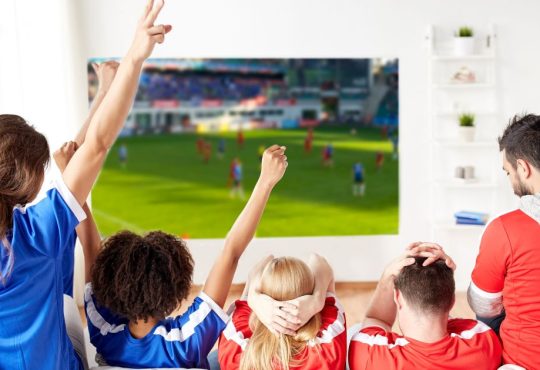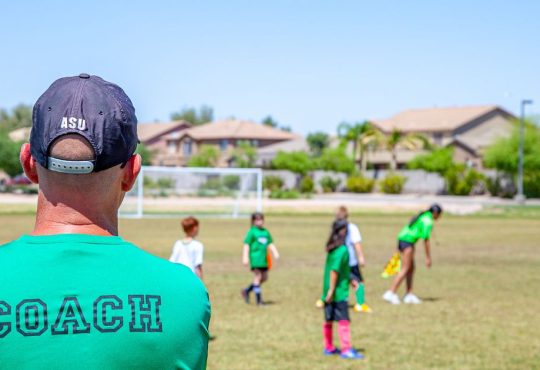Imagine this: the final moments of a tight soccer match. The score is tied, and the ball lands at your feet. You know this is your chance to make the winning play. If you want to be the player who rises to the occasion, it’s time to take your skills to the next level. Whether you’re a casual player or dreaming of making it big, the key to getting better in playing soccer lies in a mix of practice, technique, and strategy. Ready to turn your soccer dreams into reality? Let’s dive into the top strategies that will help you elevate your game.
Improving at soccer isn’t just about kicking a ball and running around; it’s a blend of physical training, mental focus, and smart practice. In this article, we’ll break down effective ways to enhance your soccer skills, covering everything from basic techniques to advanced strategies. By following these tips, you’ll build a solid foundation that can help you excel on the field.
1. Master the Basics: Dribbling, Passing, and Shooting
Before you can become a soccer star, perfecting the fundamentals is crucial. Here’s how to get better in playing soccer by honing your dribbling, passing, and shooting skills:
Dribbling
Use Both Feet:
- Balance and Coordination: Practicing with both feet helps improve your balance and coordination, making you a more flexible player on the field. Start by dribbling in a straight line with your non-dominant foot to build confidence and control.
- Dribbling Exercises: Engage in exercises like “inside-outside touches,” where you alternate using the inside and outside of each foot while moving the ball. This enhances your ability to maneuver and change direction swiftly.
Control Speed:
- Varied Pace Drills: Incorporate drills that involve changing speeds while dribbling. For example, dribble quickly over short distances and then slow down for precision control. This helps you maintain possession and make quick adjustments based on game situations.
- Pressure Situations: Practice dribbling under pressure by simulating game scenarios with defenders or obstacles. This prepares you to retain control when faced with defensive challenges.
Dribble Against Cones:
- Agility and Precision: Set up cones in a straight line or zigzag pattern and practice weaving through them. Focus on keeping the ball close to your feet while making sharp turns. This improves your maneuverability and ability to navigate tight spaces.
- Vary the Drills: Change the spacing of the cones and the speed of your dribbling to challenge yourself. For instance, set up cones closer together for tight control drills or further apart for speed and agility training.
Passing
Accuracy Over Power:
- Precision Drills: Work on passing drills that emphasize accuracy, such as hitting targets or passing through small gates. Use the inside of your foot for controlled, accurate passes. This technique is ideal for short to medium-range passes where precision is key.
- Passing Partners: Practice passing with a partner, focusing on hitting specific spots on their body or a designated target area. This helps refine your ability to deliver precise passes under various conditions.
One-Touch Passing:
- Quick Reactions: Improve your reaction time and passing efficiency with one-touch passing drills. Use a wall or a partner to receive and pass the ball with minimal touches. This enhances your ability to play quickly and maintain the flow of the game.
- Combination Plays: Incorporate one-touch passing into small-sided games or scrimmages to simulate real-game scenarios. This helps you develop a natural feel for quick, efficient passing and enhances team chemistry.
Shooting
Focus on Technique:
- Shooting Form: Ensure your body is balanced and aligned when striking the ball. Your non-kicking foot should be placed beside the ball, and your kicking foot should follow through for power and accuracy. Aim for the corners of the goal, as this increases the likelihood of scoring.
- Repetitive Practice: Spend time practicing shooting from different angles and distances. Use drills that focus on both power shots and precise finishes to build a well-rounded shooting technique.
Practice Different Shots:
- Varied Techniques: Work on a range of shooting techniques, including volleys, chips, and driven shots. For example, practice volleys by striking the ball mid-air, and work on chips by gently lifting the ball over the goalkeeper. This versatility makes you more unpredictable and dangerous in front of the goal.
- Game Simulation: Incorporate shooting drills that simulate game conditions, such as shooting under pressure or after making a run. This prepares you to perform under the stress of actual match scenarios.
2. Improve Your Physical Fitness
Being fit is essential for excelling in soccer. To get better in playing soccer, focusing on building strength, endurance, and agility will make a significant difference. Here’s a detailed breakdown of how to enhance each of these physical aspects:
Strength Training
Core Workouts:
- Planks: Perform planks by holding your body in a straight line from head to heels while resting on your forearms and toes. Aim to hold the position for 30–60 seconds, gradually increasing as your strength improves. Planks help build core stability, which is crucial for maintaining balance and power during play.
- Russian Twists: Sit on the ground with your knees bent and your feet lifted slightly. Lean back slightly and twist your torso from side to side, holding a weight or medicine ball for added resistance. This exercise enhances rotational strength and stability, aiding in effective turns and balance during dribbling and shooting.
Leg Exercises:
- Squats: Stand with your feet shoulder-width apart and lower your body by bending your knees while keeping your back straight. Aim for a deep squat, and then push through your heels to return to the starting position. Squats build overall leg strength, essential for powerful kicks and sprinting.
- Lunges: Step forward with one leg, lowering your hips until both knees are bent at about a 90-degree angle. Push back to the starting position and switch legs. Lunges improve leg strength, stability, and balance, which are critical for quick changes in direction and maintaining control over the ball.
Endurance Training
Interval Running:
- High-Intensity Intervals: Incorporate interval running by alternating between high-intensity sprints and lower-intensity recovery periods. For example, sprint for 30 seconds, followed by 1 minute of jogging or walking. This type of training enhances your stamina and speed, helping you maintain high performance throughout the match.
- Varied Intervals: Change the length and intensity of your intervals to simulate different game scenarios. Short, intense bursts can mimic the demands of sudden sprints, while longer intervals help build overall endurance.
Long-Distance Runs:
- Steady-State Runs: Include steady-state runs at a moderate pace to build cardiovascular endurance. Aim for runs that last 30–60 minutes, depending on your fitness level. This type of training improves your overall fitness and helps you sustain energy throughout the game.
- Progressive Runs: Gradually increase the distance and duration of your long runs over time. This progressive approach ensures that your stamina continues to develop, allowing you to maintain a high level of performance.
Agility Drills
Cone Drills:
- Shuttle Runs: Set up a series of cones in a straight line or zigzag pattern. Perform shuttle runs by sprinting from cone to cone, changing direction quickly at each point. This drill enhances your ability to change direction rapidly, which is vital for evading defenders and maintaining possession.
- Dribbling Through Cones: Practice dribbling the ball through a series of cones, focusing on quick, controlled movements. This drill improves your agility with the ball and helps you navigate tight spaces more effectively.
Ladder Drills:
- Footwork Patterns: Use an agility ladder to perform various footwork patterns, such as high knees, lateral shuffles, and in-and-out steps. These exercises improve foot speed, coordination, and overall agility, which are essential for quick changes in direction and maintaining balance.
- Speed and Coordination: Incorporate ladder drills into your training routine to enhance both speed and coordination. Focus on maintaining proper form and increasing the speed of your movements as you become more proficient.
3. Develop Tactical Understanding
Understanding soccer tactics is crucial for elevating your game. While physical skills are important, tactical knowledge allows you to make smarter decisions, anticipate plays, and use the space on the field more effectively. Here’s how to deepen your tactical understanding to get better in playing soccer:
Study Game Tactics
Watch Professional Matches:
- Positioning and Movement: Observe how professional players position themselves and move on the field. Pay attention to how they create space, support teammates, and exploit weaknesses in the opposition’s defense. For example, note how a midfielder might drop back to support the defense or how a forward makes runs to pull defenders out of position.
- Decision Making: Watch how professionals make decisions under pressure. Notice their choices for passing, dribbling, and shooting. Analyze their decision-making processes and try to apply similar strategies in your own game.
Learn Different Formations:
- Common Formations: Familiarize yourself with common soccer formations like 4-4-2, 4-3-3, and 3-5-2. Understand the roles and responsibilities associated with each position in these formations. For instance, in a 4-4-2, the two forwards might focus on pressuring the opposition’s defense, while the midfielders support both the defense and attack.
- Formation Flexibility: Learn how different formations can be adapted based on the game situation. For example, a team might switch from a defensive 4-4-2 to a more attacking 4-3-3 if they need to chase a goal. Understanding these shifts helps you anticipate changes and adjust your play accordingly.
Play Smart
Anticipate Opponents:
- Reading the Game: Develop the ability to read the game by observing your opponents’ body language and movements. Anticipate their next moves based on their positioning and actions. For instance, if an opponent is gearing up to receive a pass, position yourself to intercept or challenge them effectively.
- Defensive Awareness: Improve your defensive anticipation by studying common attacking patterns and movements. Learn how attackers typically try to break through defenses and position yourself to counteract those strategies.
Use Space Wisely:
- Finding Open Space: Position yourself in open areas of the field to receive the ball and make effective plays. Avoid crowding around the ball and instead, find spaces where you can be most useful to your team. For example, as a forward, make runs into spaces behind the defense to create goal-scoring opportunities.
- Creating Opportunities: Use your positioning to create chances for your teammates. For instance, as a midfielder, if you draw defenders towards you, you can create space for a teammate to receive the ball and make a play. Recognize when to make runs, draw defenders, or provide support to enhance your team’s offensive efforts.
4. Enhance Your Mental Game
Soccer isn’t just physical; it’s mental too. Strengthen your mental game to get better in playing soccer:
Build Confidence
- Set Goals: Establish clear, achievable goals for your performance and work towards them.
- Visualize Success: Regularly visualize successful plays and scenarios to boost your confidence.
Stay Focused
- Concentration Exercises: Practice focusing techniques, such as mindfulness or meditation, to maintain your concentration during games.
- Manage Stress: Learn techniques for managing stress to stay calm under pressure.
5. Work on Your Teamwork
Soccer is a team sport, and effective communication and collaboration are key. Here’s how to improve teamwork:
Communicate Effectively
- Use Clear Signals: Develop a system of verbal and non-verbal signals with your teammates.
- Encourage Each Other: Support your teammates and foster a positive playing environment.
Understand Roles
- Know Your Position: Be clear on your role and responsibilities during a game.
- Adapt to Teammates: Learn to adapt to your teammates’ playing styles and strengths.
6. Practice Regularly
Consistent practice is crucial for improvement. Here’s how to make the most of your training sessions:
Create a Training Schedule
- Set Regular Practice Times: Establish a routine that includes specific times for skill practice, fitness, and game strategy.
- Mix It Up: Include a variety of drills and exercises to keep your training engaging.
Track Your Progress
- Keep a Journal: Document your practice sessions and progress to identify areas for improvement.
- Set Milestones: Regularly set and review milestones to stay motivated and measure your growth.
7. Seek Professional Guidance
Sometimes, you need expert advice to really excel. Consider these options:
Hire a Coach
- Personal Coaching: Work with a coach to receive tailored feedback and guidance.
- Group Training: Join group sessions to learn from experienced coaches and interact with other players.
Attend Soccer Camps
- Skill Development: Participate in soccer camps to receive focused training on specific skills.
- Exposure to New Techniques: Learn new techniques and strategies from experienced coaches and players.
8. Use Technology to Your Advantage
Leverage modern technology to enhance your soccer skills:
Video Analysis
- Review Footage: Analyze videos of your games to identify strengths and areas for improvement.
- Learn from Others: Watch videos of professional players to understand their techniques and strategies.
Training Apps
- Skill-Building Apps: Use apps designed for soccer training to practice skills and track your progress.
- Fitness Trackers: Monitor your fitness levels and training intensity with wearable technology.
9. Play Regularly and Compete
Real game experience is invaluable for improvement. Here’s how to gain more playing time:
Join a Local League
- Regular Matches: Play in local leagues or pick-up games to apply your skills in real scenarios.
- Compete in Tournaments: Participate in tournaments to gain experience and challenge yourself.
Practice with Different Opponents
- Diverse Challenges: Play against teams with varying styles and strengths to adapt your gameplay.
- Learn from Defeats: Use losses as learning opportunities to refine your skills and strategies.
10. Stay Motivated and Have Fun
Maintaining motivation is key to continuous improvement. Here’s how to stay inspired:
Set Personal Goals
- Short-Term Goals: Establish small, achievable goals for each practice session or game.
- Long-Term Goals: Aim for bigger milestones, such as mastering a specific skill or making a team.
Enjoy the Game
- Focus on Fun: Remember why you started playing soccer and keep the enjoyment factor high.
- Celebrate Progress: Acknowledge and celebrate your improvements, no matter how small.
Conclusion
Getting better in playing soccer is a multifaceted journey that requires dedication, practice, and a strategic approach. By mastering the basics, improving your physical and mental fitness, and continuously challenging yourself, you’ll see noticeable progress on the field. Embrace the process of learning and growth, and remember that each practice session is a step closer to becoming a better player.





